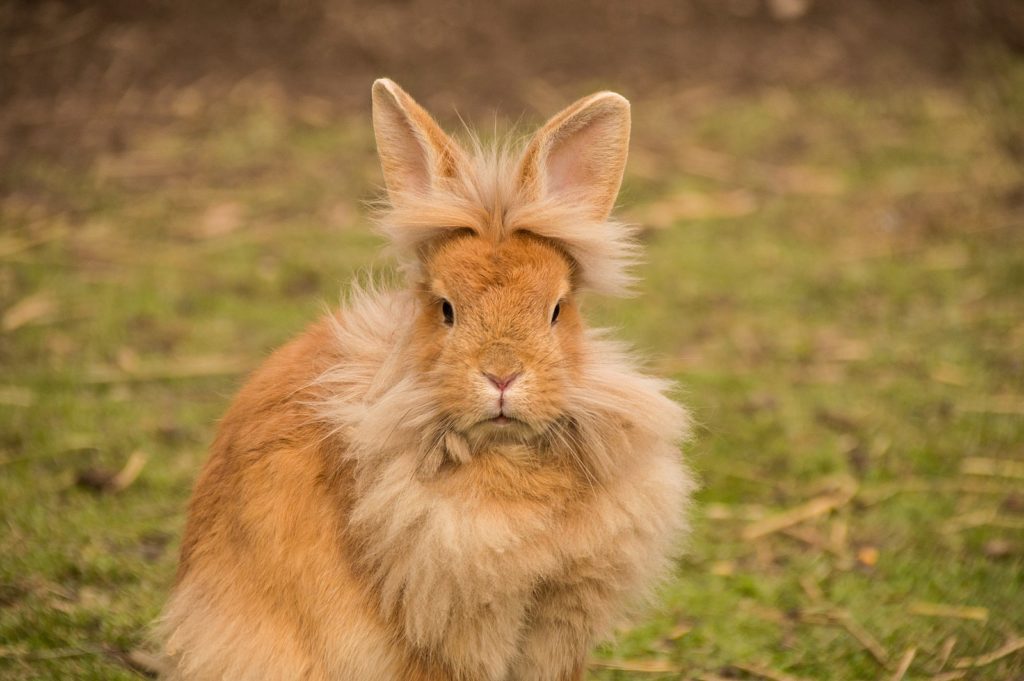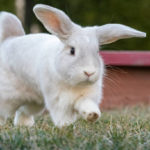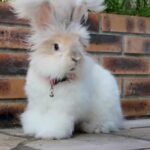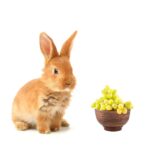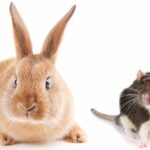The Lionhead rabbit is a dwarf rabbit breed that has recently made its way to the United States (in 1998, to be exact).
Their name comes from their spectacular coat, therefore they haven’t gone ignored.
These adorable rabbits are easily distinguished by their wool mane, which draws attention to them in any setting.
The Lionhead is a superb pet, even for first-time owners, because of its wonderful temperament.
This breed of rabbit is gentle, peaceful, and excellent with kids, however, they may require a little more maintenance than other breeds because of their coat.
Read on to find out more about Lionhead rabbits and determine if they are the appropriate breed for you.
History Of the Lionhead Rabbit
Although the Lionhead rabbit was developed in France and Belgium, the French Federation of Cuniculture does not officially acknowledge it.
A long-coated dwarf rabbit is said to have resulted from the crossing of a small Swiss Fox with a Netherland dwarf.
The resulting genetic mutation resulted in the development of wool on the face and upper body.
One common nickname for this gene is “mane” (for “mane”). Similar claims, such as the lionhead being the offspring of a cross between a Netherland Dwarf and a Jersey Wooly, have not been verified.
This is because the mane gene is distinct from the gene responsible for the woolly coats of wooled rabbits.
Following its meteoric rise to fame across Europe, the Lionhead rabbit finally made its way to the United States in the late ’90s.
The British Rare Breeds Conservancy (BRC) has officially recognized Lionheads as a breed since 2002.
The Lionhead, in both its Tortoise and Ruby-Eyed White variants, was officially recognized by ARBA in 2013.
[4] Since February 1, 2014, Lionheads can compete for Best in Show and earn points toward the Grand Champion title.
Columbus, Ohio is the site of the annual Lionhead Exhibition Specialty show hosted by the North American Lionhead Rabbit Club (NALRC). About 300–500 participants and 50–80 exhibitors from the United States and Canada are typical for a Lionhead breed show.
Lionhead Rabbit Behavior and Temperament
Most lionhead rabbits are bright, friendly, and active. They spend most of their time laughing and chatting with one another.
The majority develop warm and loving relationships with their human caretakers and thrive on lots of affection.
Some lionheads, though, are more nervous than others.
Although they rarely bite, they may scratch if they are frightened. The vast majority of rabbits dislike being picked up. 1
The lionhead rabbit requires company, thus keeping multiple rabbits is recommended. Spaying and neutering allow members of the opposing sex to coexist peacefully.
It’s also worth noting that some rabbits develop close relationships with other pets in the home, such as docile and well-behaved canines and felines.
However, it is essential to introduce animals (including other rabbits) gradually and safely to ensure that they can coexist peacefully.
Pet rabbits are typically shy critters who need twice-daily feedings and frequent brushing.
They also require daily supervised playtime outside of their habitat.
In addition, it’s a good idea to provide them with toys, particularly chew toys, both inside and outside of their cage.
Lack of mental and physical stimulation in rabbits can lead to harmful behaviors like gnawing on furniture or digging holes.
Size Information
Lionhead rabbits normally measure between 8 and 10 inches in length and weigh less than 4 pounds.
Their length can range anywhere from 8 to 10 inches.
Breed Origin
Breeders in Belgium came up with the idea of crossing a Swiss Fox with a Netherland Dwarf rabbit, which resulted in the creation of the Lionhead rabbit.
This led to the development of a genetic mutation in the rabbit, which resulted in the growth of wool around the head and on the sides of the body.
The name “mane” eventually stuck to this particular gene.
They immediately became popular all around the world as a result of their one-of-a-kind physical look, and it wasn’t until the late 1990s that they were brought to the United States.
Characteristics of the Lionhead Rabbit
With their distinctive mane gene, Lionhead rabbits can’t be missed.
The domesticated and zoo-exhibition versions of these rabbits enjoy widespread acclaim.
The price of a Lionhead bunny ranges from $20 to $125, depending on its condition. Price increases are common for rabbits of show quality.
Appearance
The maximum healthy weight for a Lionhead is 3.5 pounds. They are little in stature, with pointed ears that sit proudly atop their heads.
They sport a mane, as previously indicated.
The genes they acquire from their parents will determine whether or if this mane is single or double.
Two copies of the mane gene will be present in a rabbit with a double mane, but only one in a rabbit with a single mane.
Examining a newborn rabbit is the only reliable technique to tell whether it will have a single or double mane.
When born, a Lionhead with a single mane will look like any other rabbit, whereas a Lionhead with a double mane will have a distinct V shape around their skirt.
You can get the “no-mane” variant of Lionhead by passing on the “no-mane” gene.
Coat
Since the Lionhead rabbit’s wool coat is so lovely, it’s a shame that it needs so much maintenance.
Grooming is essential for the health of the Lionhead because it keeps the coat from matting and tangling.
Above, we discussed the options for your Lionhead’s mane length: single or double.
An adult Lionhead with a double mane will have a longer mane and wool on its flanks, which some people describe as a “skirt,” while a young Lionhead with a single mane will have a wispy, thin mane around its head, ears, chin, and sometimes on the chest.
Color
The American Rabbit Breeders Association (ARBA) officially recognizes the following color variations of the Lionhead rabbit: tortoise (black, blue, chocolate, lilac), ruby-eyed white (REW), blue-eyed white (BEW), chocolate, chestnut agouti, silver marten, pointed white, sable point, seal, and siamese sable.
LIFESPAN
The Lionhead rabbit is one of the longest-living types, with an average lifespan of 8-10 years.
Housing
The lionhead rabbit, despite its little size, is a very active animal that requires a large area in which to exercise.
If you have a small rabbit like a lionhead, its cage should be 18 inches by 24 inches and high enough for the rabbit to stand on its hind legs.
Having numerous rabbits, however, requires a larger cage.
It’s best to keep rabbits out of cages with wire floors, as the sharp edges can cause serious injury to their feet.
A dog box with a plastic base may prove to be useful. To provide even more room while keeping the rabbit secure, some owners choose to use a dog exercise pen.
To prevent draughts from entering the enclosure, careful placement is required.
A rabbit’s enclosure should have a litter box, toys, food and water bowls, and a shelf for hopping.
Multi-story pens can benefit from the addition of tunnels and ramps built into the concrete floor.
The floor of the cage should be large enough for the rabbit to lie down with its rear legs fully extended.
Make sure that the entire outside space is bunny-proofed before letting your rabbit out of its cage.
It is common knowledge that rabbits will gnaw on everything they can get their paws on, including live wires and other hazards.
Specific Substrate Needs
There ought to be nonslip material on the floor of the cage.
The fluffy comfort of washable carpeting is appreciated by many rabbit owners.
And don’t forget to scatter some straw for your rabbit to use as bedding.
Never use clumping litter and only use paper litter in the litter box.
The litter box should be cleaned once every other day, and the entire cage should be washed with mild soap and water once every week.
What Do Lionhead Rabbits Eat & Drink?
Herbivores are not what rabbits are about.
They also need a diet that helps to wear down their teeth naturally because their teeth are constantly growing.
Give your lion head as much timothy hay or other grass hay as it wants every day.
You can either use a hopper, which is a type of feeder or just pile hay inside the pen. Make sure the rabbit never goes without hay.
Leafy greens like lettuce, herbs, and carrot tops should also be provided. …and provide fewer servings of other fruits and vegetables like carrots.
Simply place a small dish or fresh food on the floor of the enclosure.
The recommended frequency of feeding is once or twice daily, but fresh foods should be removed after a few hours to prevent spoilage.
To find out how much and what kind of food your rabbit should be eating, you should talk to your vet.
Furthermore, only provide a small number of rabbit pellets. Obesity and digestive problems are two side effects of eating too many pellets.
Consult your veterinarian about a feeding schedule.
Put enough pellets for a day into the small ceramic bowl and place it inside the cage.
If any pellets remain uneaten after 24 hours, discard them before giving the next day’s serving.
Last but not least, provide clean water for your rabbit daily. A bottle or ceramic water pitcher will do.
Just keep the bottle filled and make sure your rabbit understands how to use it. Every day, you should replace the water.
Common health problems
Lionhead rabbits, like all pet rabbits, are susceptible to a number of the same diseases.
- problems with digestion like constipation and diarrhea
- Problems with the eyes, such as corneal ulcers
- Contagious respiratory diseases
- Mites and fleas are just the beginning when it comes to skin problems.
If your rabbit isn’t getting enough exercise and chew time, it can develop overgrown teeth.
5 If your rabbit is having trouble eating or seems to be losing weight, it may be due to this.
If a pet needs to have its teeth trimmed, a veterinarian can do it.
Family Compatibility And Trainability
The Lionhead rabbit is a bunny that bonds to its owners very quickly and loves to be around them.
They are suitable for individuals, couples, the elderly, and families with children and their small size means they don’t need a lot of space and are suited to apartment living.
While training a rabbit isn’t as easy as training a cat or a dog, it can be done! You can teach your Lionhead to use a litter box. You can also try teaching them to come when their name is called!
Many owners prefer to keep their Lionhead as an indoor rabbit instead of keeping their hutch outside.
As small bunnies, they are more exposed to predators when outside and also more open to the elements.
However, this doesn’t mean they can’t live outdoors — just make sure their hutch is really secure and protective from wind, rain, and sun.
Your Lionhead’s hutch should be large enough that they can easily move around inside.
Try to stay away from hutches with wire floors as these can cause sore hocks within rabbits. Take a look at the hutch we recommend below.
